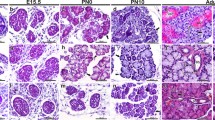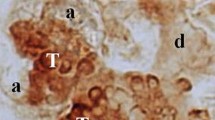Abstract
Keratin 5 (K5) is a marker of basal progenitor cells in the epithelia of a number of organs. During prenatal development of the submandibular gland (SMG) in mice, K5+ progenitor cells in the developing epithelia play important roles in its organogenesis. Although K5+ cells are also present in the adult mouse SMG and may function in tissue regeneration, their histological localization has not yet investigated in detail. In the present study, we examined the immunohistochemical localization of K5 in the SMG in adult and postnatal developing mice. At birth, K5 immunoreactivity was detected in the entire duct system, in which it was localized in the basal cells of a double-layered epithelium, but was not detected in the terminal tubule or myoepithelial cells. At postnatal weeks 1–3, with the development of intercalated ducts (ID), striated ducts (SD), and excretory ducts (ED), K5-immunoreactive basal cells were gradually restricted to the ED and the proximal double-layered portions of the ID connecting to the SD. At the same time, K5 immunoreactivity appeared in myoepithelial cells, in which its positive ratio gradually increased. In adults, K5 immunoreactivity was localized to most myoepithelial cells, most basal cells in the ED, and a small number of ID cells at the boundary between the ID and SD in the female SMG or between the ID and granular convoluted tubules in the male SMG. These results suggest that K5 is a marker of differentiated myoepithelial cells and duct progenitor cells in the mouse SMG.






Similar content being viewed by others
References
Alvares EP, Sesso A (1975) Cell proliferation, differentiation and transformation in the rat submandibular gland during early postnatal growth. A quantitative and morphological study. Arch Histol Jpn 38:177–208
Aure MH, Konieczny SF, Ovitt CE (2015) Salivary gland homeostasis is maintained through acinar cell self-duplication. Dev Cell 33:231–237
Ball WD, Hand AR, Moreira JE, Johnson AO (1988) A secretory protein restricted to type I cells in neonatal rat submandibular glands. Dev Biol 129:464–475
Chang WW, Barka T (1974) Stimulation of acinar cell proliferation by isoproterenol in the postnatal rat submandibular gland. Anat Rec 178:203–209
Chibly AM, Querin L, Harris Z, Limesand KH (2014) Label-retaining cells in the adult murine salivary glands possess characteristics of adult progenitor cells. PLoS ONE 9:e107893
Coppes R, Stokman M (2011) Stem cells and the repair of radiation-induced salivary gland damage. Oral Dis 17:143–153
Cutler LS, Chaudhry AP (1973) Differentiation of the myoepithelial cells of the rat submandibular gland in vivo and in vitro: an ultrastructural study. J Morphol 140:343–354
Denny PC, Chai Y, Klauser DK, Denny PA (1993) Parenchymal cell proliferation and mechanisms for maintenance of granular duct and acinar cell populations in adult male mouse submandibular gland. Anat Rec 235:475–485
Denny PC, Ball WD, Redman RS (1997) Salivary glands: a paradigm for diversity of gland development. Crit Rev Oral Biol Med 8:51–75
Denny PC, Liu P, Denny PA (1999) Evidence of a phenotypically determined ductal cell lineage in mouse salivary glands. Anat Rec 256:84–90
Dvorak M (1969) The secretory cells in the submaxillary gland in the perinatal period of development in the rat. Z Zellforsch 99:346–356
Fuchs EV, Coppock SM, Green H, Cleveland DW (1981) Two distinct classes of keratin genes and their evolutionary significance. Cell 27:75–84
Gresik EW (1980) Postnatal developmental changes in submandibular glands of rats and mice. J Histochem Cytochem 28:860–870
Gresik EW, MacRae EK (1975) The postnatal development of the sexually dimorphic duct system and of amylase activity in the submandibular glands of mice. Cell Tissue Res 157:411–422
Gugliotta P, Sapino A, Macri L, Skalli O, Gabbiani G, Bussolati G (1988) Specific demonstration of myoepithelial cells by anti-alpha smooth muscle actin antibody. J Histochem Cytochem 36:659–663
Hai B, Yang Z, Millar SE, Choi YS, Taketo MM, Nagy A, Liu F (2010) Wnt/β-catenin signaling regulates postnatal development and regeneration of the salivary gland. Stem Cells Dev 19:1793–1801
Hecht R, Connelly M, Marchetti L, Ball WD, Hand AR (2000) Cell death during development of intercalated ducts in the rat submandibular gland. Anat Rec 258:349–358
Jacoby F, Leeson CR (1959) The postnatal development of the rat submaxillary gland. J Anat 93:201–216
Knosp WM, Knox SM, Hoffman MP (2012) Salivary gland organogenesis. WIREs Dev Biol 1:69–82
Knox SM, Lombaert IMA, Reed X, Vitale-Cross L, Gutkind JS, Hoffman MP (2010) Parasympathetic innervation maintains epithelial progenitor cells during salivary organogenesis. Science 329:1645–1647
Lombaert IMA, Hoffman MP (2010) Epithelial stem/progenitor cells in the embryonic mouse submandibular gland. Front Oral Biol 14:90–106
Man Y-G, Ball WD, Marchetti L, Hand AR (2001) Contributions of intercalated duct cells to the normal parenchyma of submandibular glands of adult rats. Anat Rec 263:202–214
Moll R, Franke WW, Schiller DL, Geiger B, Krepler R (1982) The catalog of human cytokeratins: patterns of expression in normal epithelia, tumors and cultured cells. Cell 31:11–24
Moreira JE, Tabak LA, Bedi GS, Culp DJ, Hand AR (1989) Light and electron microscopic immunolocalization of rat submandibular gland mucin-glycoprotein and glutamine/glutamic acid-rich proteins. J Histochem Cytochem 37:515–528
Moumen M, Chiche A, Cagnet S, Petit V, Raymond K, Faraldo MM, Deugnier M-A, Glukhova MA (2011) The mammary myoepithelial cell. Int J Dev Biol 55:763–771
Nelson DA, Manhardt C, Kamath V, Sui Y, Santamaria-Pang A, Can A, Bello M, Corwin A, Dinn SR, Lazare M, Gervais EM, Sequeira SJ, Peters SB, Ginty F, Gerdes MJ, Larsen M (2013) Quantitative single cell analysis of cell population dynamics during submandibular salivary gland development and differentiation. Biol Open 2:439–447
Ogawa Y, Yamauchi S, Ohnishi A, Ito R, Ijuhin N (1999) Immunohistochemistry of myoepithelial cells during development of the rat salivary glands. Anat Embryol 200:215–228
Purkis PE, Steel JB, Mackenzie IC, Nathrath WBJ, Leigh IM, Lane EB (1990) Antibody markers of basal cells in complex epithelia. J Cell Sci 97:39–50
Raimondi AR, Vitale-Cross L, Amornphimoltham P, Gutkind JS, Molinolo A (2006) Rapid development of salivary gland carcinomas upon conditional expression of K-ras driven by the cytokeratin 5 promoter. Am J Pathol 168:1654–1665
Ramirez A, Bravo A, Jorcano JL, Vidal M (1994) Sequences 5’ of the bovine keratin 5 gene direct tissue-and cell-type-specific expression of a lacZ gene in the adult and during development. Differentiation 58:53–64
Redman RS (1994) Myoepithelium of salivary glands. Microsc Res Tech 27:25–45
Rock JR, Onaitis MW, Rawlins EL, Lu Y, Clark CP, Xue Y, Randell SH, Hogan BL (2009) Basal cells as stem cells of the mouse trachea and human airway epithelium. Proc Natl Acad Sci USA 106:12771–12775
Srinivasan R, Chang WW (1979) The postnatal development of the submandibular gland of the mouse. Cell Tissue Res 198:363–371
Tucker AS (2007) Salivary gland development. Semin Cell Dev Biol 18:237–244
Yamashina S, Barka T (1972) Localization of peroxidase activity in the developing submandibular gland of normal and isoproterenol-treated rats. J Histochem Cytochem 20:855–872
Acknowledgments
The authors thank Mr. Shuichi Yamazaki for his technical assistance. This study was supported by Grants-in-Aid for Scientific Research # 20590187 and 26460270 from the Ministry of Education, Culture, Sports, Science and Technology of Japan to SI.
Author information
Authors and Affiliations
Corresponding author
Ethics declarations
Conflict of interest
None.
Rights and permissions
About this article
Cite this article
Yamamoto, M., Nakata, H., Kumchantuek, T. et al. Immunohistochemical localization of keratin 5 in the submandibular gland in adult and postnatal developing mice. Histochem Cell Biol 145, 327–339 (2016). https://doi.org/10.1007/s00418-015-1392-5
Accepted:
Published:
Issue Date:
DOI: https://doi.org/10.1007/s00418-015-1392-5




